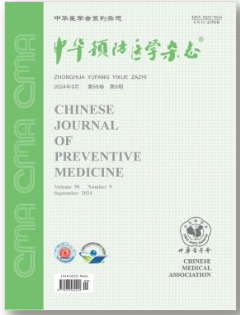[河南省某医院2021 - 2023年产碳青霉烯酶大肠杆菌流行病学分析]。
摘要
目的:分析河南省中医院2021 - 2023年产碳青霉烯酶大肠杆菌耐药基因的流行病学特征,为控制产碳青霉烯酶大肠杆菌医院感染提供数据支持和理论依据。方法:采用横断研究方法,对2021 - 2023年河南省中医院临床微生物实验室经vitech -2 Compact鉴定和药敏试验确认的30株耐碳青霉烯类大肠杆菌(CRECO)进行检测,采用碳青霉烯酶抑制剂增强试验对碳青霉烯酶进行初步筛选;采用胶体金免疫层析和聚合酶链反应(PCR)分别测定常见碳青霉烯酶(blaKPC、blaNDM、blaVIM、blaIMP、blaOXA)的表型和基因型,并采用PCR方法确定常见扩展谱β -内酰胺酶(ESBL)的基因型(blaSHV、blaTEM、blaCTX)。对碳青霉烯酶和ESBL阳性菌株的PCR扩增产物进行sanger测序,并将测序产物在Blast网站上进行比较,以确定碳青霉烯酶和ESBL的确切基因型。采用Achtman多位点序列分型方案对CPECO进行序列分型(ST),确定不同菌株间的克隆关系。结果:共筛选到21株CPECO菌株。药敏试验结果显示,CPECO菌株普遍耐药,对单环类(氨曲南)和甲氧苄啶/磺胺甲恶唑的耐药率均在60%以上(16/ 21,14 /21),对其他抗菌药物的耐药率均为100%。仅对氨基糖苷类和磷霉素敏感性较高,未发现对替加环素和粘菌素耐药的菌株。胶体金免疫层析检测blaNDM型18种,blaKPC型2种,blaIMP型1种。耐药基因PCR产物测序结果显示,blaNDM-5菌株17株,blaNDM-4菌株1株,blaKPC-2菌株2株,blaIMP-4菌株1株,与筛选试验和胶体金免疫层析结果完全一致。ESBL耐药基因检测结果显示,blaCTX-M检出率为42.9%(9/21),blaCTX-M检出率为33.3%(7/21),blaSHV检出率为4.8%(1/21)。blaNDM产生同时携带ESBL耐药基因的CPECO的比例为27.8%(5/18)。MLST分型结果显示有11种序列类型(STs),包括1种ST155克隆复合物和9种单例STs。其中ST167菌株7株,ST410菌株5株,ST58、ST68、ST69、ST93、ST131、ST155、ST648、ST1114、ST3268各1株。结论:本研究发现CPECO的主要耐药机制是产生blaNDM-5碳青霉烯酶,且较高比例的菌株同时携带blandm - 1d和/或blaCTX-M-15 ESBLs。MLST分型发现CPECO流行株具有一定的多态性,但ST167与ST410之间存在多克隆复合物的克隆传播。Objective: To analyze the epidemiological characteristics of drug resistance genes of carbapenemase-producing Escherichia coli (CPECO) in Henan Province Hospital of Traditional Chinese Medicine from 2021 to 2023, providing data support and theoretical basis for controlling nosocomial infections of CPECO. Methods: Using a cross-sectional study, 30 carbapenem-resistant Escherichia coli (CRECO) strains confirmed by VITEK-2 Compact identification and drug sensitivity test in the Clinical Microbiology Laboratory of Henan Province Hospital of Traditional Chinese Medicine from 2021 to 2023 were tested, using carbapenemase inhibitor enhancement test to conduct preliminary screening of carbapenemases, and colloidal gold immunochromatography and polymerase chain reaction (PCR) were used to determine the phenotypes and genotypes of common carbapenemases (blaKPC, blaNDM, blaVIM, blaIMP, blaOXA) respectively, and the genotypes (blaSHV, blaTEM, blaCTX) of common extended Spectrum beta-lactamases (ESBL) were confirmed using PCR. The PCR amplification products of carbapenemase and ESBL positive strains were Sanger-sequenced, and the sequencing products were compared on the Blast website to determine the exact carbapenemase and ESBL genotypes. Sequence typing (ST) was performed on CPECO using the Achtman multi-locus sequence typing scheme to determine the cloning relationship between different strains. Results: A total of 21 CPECO strains were screened. Drug sensitivity test results showed that CPECO strains showed widespread drug resistance, with the resistance rate to monocyclic (aztreonam) and trimethoprim/sulfamethoxazole being over 60%(16/21, 14/21), and the resistance rate to other antibacterial drugs being 100%. Only the sensitivity to aminoglycosides and fosfomycin remained relatively high, and no strains resistant to tigecycline and colistin were found. Colloidal gold immunochromatography detected 18 blaNDM types, 2 blaKPC types, and 1 blaIMP type. Sequencing of drug resistance gene PCR products classified 17 blaNDM-5 strains, 1 blaNDM-4 strain, 2 blaKPC-2 strain, and 1 blaIMP-4 strain, which were completely consistent with the results of screening test and colloidal gold immunochromatography. ESBL resistance gene testing showed that the detection rate of blaTEM was 42.9%(9/21), blaCTX-M was 33.3%(7/21), and blaSHV was 4.8%(1/21). The rate of blaNDM producing CPECO carrying both ESBL resistance genes was 27.8%(5/18). The MLST typing results revealed 11 sequence types (STs), including one ST155 clonal complex and nine singleton STs. Among these, there were seven strains of ST167, five strains of ST410, and one strain each of ST58, ST68, ST69, ST93, ST131, ST155, ST648, ST1114, and ST3268. Conclusion: The main resistance mechanism identified in this study for CPECO was the production of blaNDM-5 carbapenemase, with a high proportion of strains also carrying blaTEM-1D and/or blaCTX-M-15 ESBLs. MLST typing found that the epidemic strain of CPECO showed certain polymorphism, but there were clonal transmission of multiple clonal complexes between ST167 and ST410.

 求助内容:
求助内容: 应助结果提醒方式:
应助结果提醒方式:


